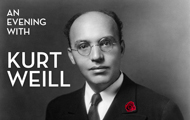MARC KRONE
'Onégin’s overture lasts about two minutes: that’s all it takes to fall in love with opera.'
Frits van der Waa
De Volkskrant
Marc Krone hits the nail right on the head with this ‘Evening with Kurt Weill’; his sober staging makes this evening all the more poingant and intense.
When preparing for ‘Die Stumme Serenade’, I visited Berlin, where I was struck by the so called Solpersteine, small copper cobblestones embedded in the streets, commemorating people who once used to live there. People that were deported or slain, or had committed suicide before and during the Second World War.
Poignant in its simplicity, because more often than not no homes remain at all.
Without one of these stones such a place would have been an anonymous street corner or an office building. By these minute signals I was suddenly granted a view into history, with all its images, details and forgotten events.
So when I got a commission to create a program with music by Weill and Eisler, I immediately knew it had to be about those people behind the Stolperseine. People who were accidentally condemned to be together. Seven people who are waiting for the ‘train of death’ in a station that no longer exists: Berlin Anhalter. And what luck: Luxor Live with its magnificent ceiling look precisely like that old, no longer existing train station!
As a tribute to all the people that make up history, I named the characters of the play after seven real people that have Stolpersteine in Berlin. You can go there and visit them.
These were their addresses:
Mehringdamm 69: Anita Jonas.
Paul-Lincke-Ufer 41: Lothar Horst Koppel.
Friedrichstrasse 34: Max Matschke.
Spreng Grimselstrasse 14: Anna Demloff.
Wielandstrasse 30: Johanna Engel.
Monbijouplatz 4: Sophie Rosa Wasser.
Paradestrasse 22: Max Westphal.
1. Das Eifersuchtsduett
2. Ballade von Marie Sanders en Kanonensong
3. Lied des Freundenmädchen en Mandalay song
4. Surabaya Johnny
5. Der Leutnant des lieben Gottes
6. Alabama song en Le train du ciel
De Volkskrant
Marc Krone hits the nail right on the head with this ‘Evening with Kurt Weill’; his sober staging makes this evening all the more poingant and intense.
When preparing for ‘Die Stumme Serenade’, I visited Berlin, where I was struck by the so called Solpersteine, small copper cobblestones embedded in the streets, commemorating people who once used to live there. People that were deported or slain, or had committed suicide before and during the Second World War.
Poignant in its simplicity, because more often than not no homes remain at all.
Without one of these stones such a place would have been an anonymous street corner or an office building. By these minute signals I was suddenly granted a view into history, with all its images, details and forgotten events.
So when I got a commission to create a program with music by Weill and Eisler, I immediately knew it had to be about those people behind the Stolperseine. People who were accidentally condemned to be together. Seven people who are waiting for the ‘train of death’ in a station that no longer exists: Berlin Anhalter. And what luck: Luxor Live with its magnificent ceiling look precisely like that old, no longer existing train station!
As a tribute to all the people that make up history, I named the characters of the play after seven real people that have Stolpersteine in Berlin. You can go there and visit them.
These were their addresses:
Mehringdamm 69: Anita Jonas.
Paul-Lincke-Ufer 41: Lothar Horst Koppel.
Friedrichstrasse 34: Max Matschke.
Spreng Grimselstrasse 14: Anna Demloff.
Wielandstrasse 30: Johanna Engel.
Monbijouplatz 4: Sophie Rosa Wasser.
Paradestrasse 22: Max Westphal.
For more video's: click on the numbers.
1. Das Eifersuchtsduett
2. Ballade von Marie Sanders en Kanonensong
3. Lied des Freundenmädchen en Mandalay song
4. Surabaya Johnny
5. Der Leutnant des lieben Gottes
6. Alabama song en Le train du ciel
| Music | Kurt Weill and Hanss Eisler |
| Musicial director | Jasper van der Waal |
| Stage director, script and staging | Marc Krone |
| Costumes | Annerieke Peek |
| Light | Alex Brok |
| With | |
| Anita Jonas | Pien van Gerven |
| Horst Lothar Koppel | Milan van Waardenburg |
| Max Matschke | Alexander Oliver |
| Anna Demloff | Merlijn Runia |
| Johanna Engel | Kikki Vanhoutem |
| Rosa Sophie Wasser | Zinzi Frohwein |
| Max Westphal | Alexander de Jong |
Click in the picture to enlarge, use spacebar for next photo.
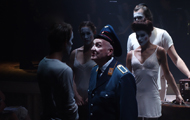 Photo: Marc Krone
Photo: Marc Krone
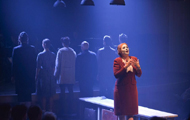 Photo: Marc Krone
Photo: Marc Krone
 CPhoto: Marc Krone
CPhoto: Marc Krone
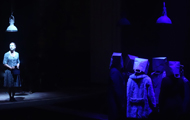 Photo: Marc Krone
Photo: Marc Krone
 Photo: Marc Krone
Photo: Marc Krone
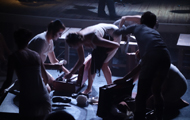 Photo: Marc Krone
Photo: Marc Krone
 Photo: Marc Krone
Photo: Marc Krone
 Photo: Marc Krone
Photo: Marc Krone
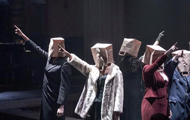 Photo: Marc Krone
Photo: Marc Krone
 Photo: Marc Krone
Photo: Marc Krone
 Photo: Marc Krone
Photo: Marc Krone
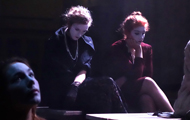 Photo: Marc Krone
Photo: Marc Krone
 Photo: Marc Krone
Photo: Marc Krone
 Photo: Marc Krone
Photo: Marc Krone
 Photo: Marc Krone
Photo: Marc Krone
 Photo: Marc Krone
Photo: Marc Krone
 CPhoto: Marc Krone
CPhoto: Marc Krone
 Photo: Marc Krone
Photo: Marc Krone
 Photo: Marc Krone
Photo: Marc Krone
 Photo: Marc Krone
Photo: Marc Krone
 Photo: Marc Krone
Photo: Marc Krone
 Photo: Marc Krone
Photo: Marc Krone
 Photo: Marc Krone
Photo: Marc Krone
 Photo: Marc Krone
Photo: Marc Krone
 Photo: Marc Krone
Photo: Marc Krone
 Photo: Marc Krone
Photo: Marc Krone
 Photo: Marc Krone
Photo: Marc Krone
 Photo: Marc Krone
Photo: Marc Krone
| 2015 | The Netherlands |

